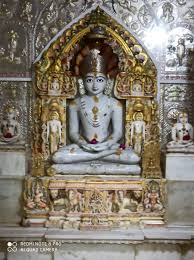What is Shri Chanda Parshwanath Jain Temple?
Shri Chanda Parshwanath Jain Temple is one of the most revered and ancient Jain tirths in Udaipur, Rajasthan. The temple is dedicated to Bhagwan Chanda Parshwanath, a unique form of Parshwanath Bhagwan, worshipped without the traditional serpent hood. The temple is known for its serene ambiance, intricate artwork, and spiritual depth.
Where is Chanda Parshwanath Temple Located in Udaipur?
This sacred Jain temple is located on Palace Road, Udaipur, in the historical region of Mewar, Rajasthan. Udaipur is a prominent city, well known for its Rajput heritage, Jain culture, and historic monuments. The temple’s central location makes it easily accessible for Jain pilgrims and tourists.
Who is Mulnayak Chanda Parshwanath Bhagwan?
The Mulnayak idol of Chanda Parshwanath Bhagwan is a white-colored idol measuring about 87 cms, seated in Padmasana. Unlike traditional Parshwanath idols, this one is without a hood, symbolizing a rare and spiritually significant form. The idol is also referred to as Udaipur Parshwanath by local devotees.
What is the History of Chanda Parshwanath Jain Tirth in Udaipur?
This ancient Jain temple in Udaipur dates back to Vikram Samvat 1325, as per the stone inscription on its structure. The temple was renovated in Vikram Samvat 1982 by Shri Raghunathsinghji Khabia. Udaipur itself was founded by Maharana Udai Singh and is surrounded by hills, creating a natural fort-like setting. Today, it is home to over 50,000 Jains and serves as a major center of Jain pilgrimage in Mewar.
How Many Jain Temples Are There in Udaipur?
Udaipur boasts more than 40 Jain temples, making it a key stop in the Jain Tirth Darshan Yatra in Rajasthan. Among them is the only temple of Shri Padmanabh Swami, the first Tirthankara of the upcoming Chovisi, which is a rare and spiritually powerful site in Jain belief.
What Are the Architectural and Artistic Highlights of the Temple?
The temple features glazed tile walls, beautifully painted ceilings, and intricate Rajput-Jain architecture. The idol of Chanda Parshwanath shines with spiritual brilliance and is said to invoke deep devotion in those who come to darshan. The temple is a beautiful blend of aesthetic elegance and sacred energy.
How to Reach Chanda Parshwanath Jain Temple, Udaipur?
Udaipur is well connected via:
- Air: Maharana Pratap Airport
- Rail: Udaipur City Railway Station
- Road: Excellent bus and taxi service from major cities
Pilgrim amenities near the temple include:
- Jain Dharamshala in Udaipur
- Jain Bhojanshala (Satvik food)
- Ayambilshala for tapasvis
- Upashraya for sadharmik stay
Nearby Jain Tirths from Udaipur
Pilgrims often combine their visit to Chanda Parshwanath with nearby Jain tirths in Rajasthan, such as:
- Kesariyaji Jain Tirth
- Kareda Parshwanath
- Samina Parshwanath
- Dungarpur Jain Temple
- Chittorgarh Jain Temples
This makes Udaipur a central spiritual hub for Jain yatras in Mewar.
Scripture Mentions of Chanda Parshwanath Bhagwan
Chanda Parshwanath is mentioned in several revered Jain texts, including:
- 135 Naam Garbhit Shri Parshwanath Stavan
- Shri Parshwanath Naammala
- Tirthmala
- Shri Parshwanath Chaitya Paripati
Additionally, the Rapar Jain Temple in Kutch, Gujarat, houses a similar idol known as Chintamani Parshwanath, also referred to as Chanda Parshwanath.
Why Visit Shri Chanda Parshwanath Jain Temple in Udaipur?
Visiting the Chanda Parshwanath Jain Temple offers a powerful spiritual experience. As one of the oldest Jain temples in Udaipur, it provides a combination of faith, history, art, and tranquility. Its connection to Jain scriptures and rare form of Bhagwan Parshwanath make it a must-visit Jain tirth in Rajasthan.
For an extensive list of Parshwanath temples and their significance, visit the 108 Parshwanath Names List.
